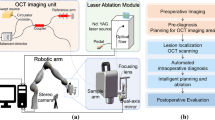Abstract
Complete removal of malignant gliomas is important for the prognosis in neurosurgery treatment. Currently, the challenge is how to detect any remaining tumors and resect them during the operation. We have developed a laser ablation system with accurate tumor analysis and fluorescence guidance for high-precision brain tumor resection during neurosurgery. A 5-aminolevulinic acid-induced fluorescent protoporphyrins IX (PpIX)-based intra-operative fluorescence measurement and corresponding spectra analysis technique is used to identify the position of tumors. A galvano mirror scanning mechanism is integrated into the fluorescence measurement and the laser ablation devices for automatic tumor area scanning and corresponding laser ablation. A set of phantom experiments was performed to evaluate the proposed system. Results showed that the galvano scanning mechanism enabled both PpIX fluorescence detection and laser ablation in the same optical axis. In vitro experiments using porcine brain were performed to evaluate the effectiveness of the automatic laser scanning, fluorescence detection, and laser ablation system. The proposed fluorescence-guided laser ablation system can provide accurate analysis and high-precision treatment for tumor resection in neurosurgery. With further improvement, the system can be used in neurosurgical implementation to provide accurate, safe, and simple surgical diagnosis and therapy.















Similar content being viewed by others
References
Avgeropoulos NG, Batchelor TT (1999) New treatment strategies for malignant gliomas. Oncologist 4:209–224
Gholipour A, Kehtarnavaz N, Briggs R, Devous M, Gopinath K (2007) Brain functional localization: a survey of image registration techniques. IEEE Trans Med Imaging 26(4):427–451
Liao H, Inomata T, Sakuma I, Dohi T (2010) 3-D augmented reality for MRI-guided surgery using integral videography autostereoscopic-image overlay. IEEE Trans Biomed Eng 57(6):1476–1486
Regula J, MacRobert AJ, Gorchein A et al (1995) Photosensitisation and photodynamic therapy of oesophageal, duodenal, and colorectal tumours using 5-aminolaevulinic acid induced protoporphyrin IX-a pilot study. Gut 36:67–75
Rossi FM et al (1996) In vitro studies on the potential use of 5-aminolevulinic acid mediated photodynamic therapy for gynaecological tumors. Br J Cancer 74:881–887
Stummer W, Stocker S, Wagner S, Stepp H, Fritsch C, Goetz C, Goetz AE, Kiefmann R, Reulen HJ (1998) Intraoperative detection of malignant gliomas by 5-aminolevulinic acid-induced porphyrin fluorescence. Neurosurgery 42:518–525
Stummer W, Novotny A, Stepp H, Goetz C, Bise K, Reulen HJ (2000) Fluorescence-guided resection of glioblastoma multiforme by using 5-aminolevulinic acid-induced porphyrins: a prospective study in 52 consecutive patients. J Neurosurg 93:1003–10130
Ciburis A, Gadonas D, Didziapetriene J, Gudinaviciene I, Grazeliene G, Kaskelyte D, Piskarskas A, Skauminas K, Smilgevicius V, Sukackaite A (2003) 5-aminolevulinic acid induced protoporphyrin IX fluorescence for detection of brain tumor cells in vivo. Exp Oncol 25(1):51–54
Maruyama T, Muragaki Y, Iseki H, Kubo O, Mochizuki M, Seo S, Sakuma I, Hori T, Takakura K (2001) Intraoperative detection of malignant gliomas using 5-Aminolevulinic acid induced protoporphyrin fluorescence, open MRI and real-time navigation system, computer assisted radiology and surgery. Int Congr Ser 1230:281–286
Leblond F, Fontaine KM, Valdes P, Ji S, Pogue BW, Hartov A, Roberts DW, Paulsen KD, (2009) Brain tumor resection guided by fluorescence imaging. In Kessel DH, (ed) Proc SPIE, volume 7164. optical methods for tumor treatment and detection: mechanisms and techniques in photodynamic therapy XVIII
Omori S, Muragaki Y, Sakuma I, Iseki H (2004) Robotic laser surgery with λ = 2.8 μm microlaser in neurosurgery. J Robtics Mechatron 16(2):122–128
Nakajima A, Iwami H, Nishimura M, Muragaki Y, Iseki H (2008) Development of Re:YAG laser surgery system for neurosurgery. J JSCAS 10(1):19–27
Yamanaka N, Yamashita H, Masamune K, Liao H, Chiba T, Dohi T (2009) A coaxial laser endoscope with arbitrary spots in endoscopic view for fetal surgery, 12th International Conference on Medical Image Computing and Computer-Assisted Intervention–MICCAI 2009. Lect Notes Comput Sci LNCS 5761:83–90
Noguchi M, Aoki E, Yoshida D et al (2006) A novel robotic laser ablation system for precision neurosurgery with intraoperative 5-ala-induced PpIX fluorescence detection. 9th International Conference on Medical Image Computing and Computer-Assisted Intervention—MICCAI 2006. Lect Notes Comput Sci LNCS 4190:543–550
Liao H, Shimaya K, Wang K, Maruyama T, Noguchi M, Muragaki Y, Kobayashi E, Iseki H, Sakuma I (2008) Combination of intraoperative 5-aminolevulinic acid induced fluorescence and 3-D MR imaging for guidance of robotic laser ablation precision neurosurgery, 11th International Conference on Medical Image Computing and Computer-Assisted Intervention—MICCAI 2008. Lect Notes Comput Sci 5242:373–380
Liao H, Noguchi M, Maruyama T, Muragaki Y, Kobayashi E, Iseki H, Sakuma I (2012) An integrated diagnosis and therapeutic system using intraoperative 5-aminolevulinic-acid-induced fluorescence guided robotic laser ablation for precision neurosurgery. Med Image Anal 16(3):754–766
Ando T, Kobayashi E, Liao H, Maruyama T, Muragaki Y, Iseki H, Kubo O, Sakuma I (2011) Precise comparison of protoporphyrin IX fluorescence spectra with pathological results for brain tumor identification. Brain Tumor Pathol 28(1):43–51
Acknowledgments
This work was supported in part by Grant for Translational Systems Biology and Medicine Initiative from the Ministry of Education, Culture, Sports, Science and Technology of Japan, and Grant-in-Aid for Scientific Research (23680049, 24650289) of the Japan Society for the Promotion of Science (to Liao).
Author information
Authors and Affiliations
Corresponding author
Rights and permissions
About this article
Cite this article
Liao, H., Fujiwara, K., Ando, T. et al. Automatic laser scanning ablation system for high-precision treatment of brain tumors. Lasers Med Sci 28, 891–900 (2013). https://doi.org/10.1007/s10103-012-1164-6
Received:
Accepted:
Published:
Issue Date:
DOI: https://doi.org/10.1007/s10103-012-1164-6




